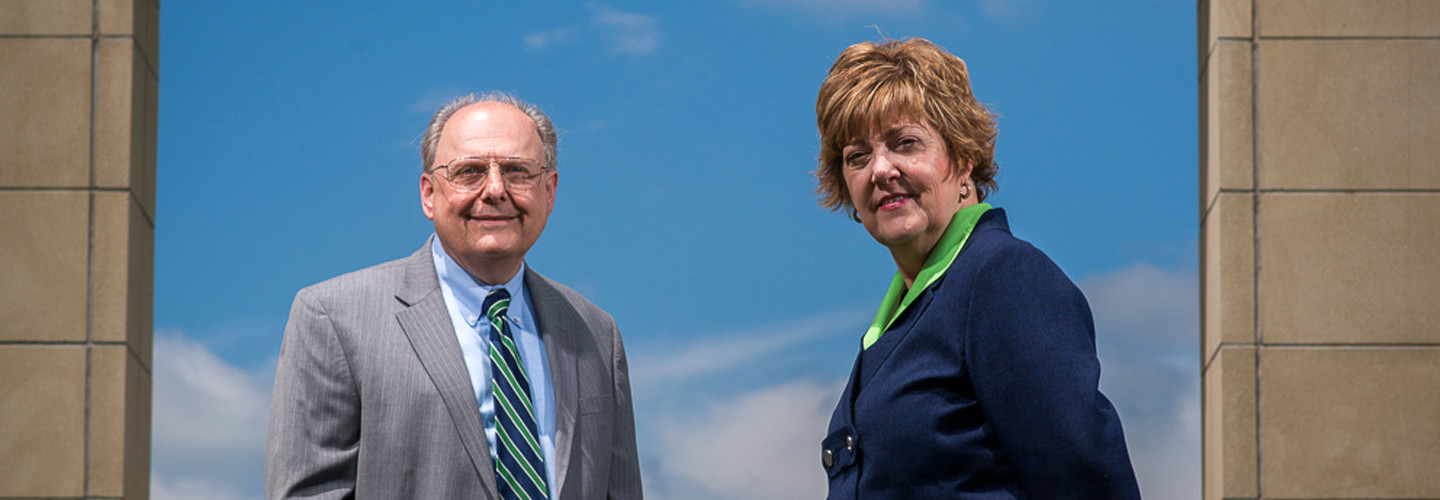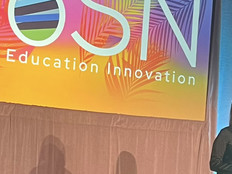How to Transition from a Print to Digital Curriculum
Geary County Schools USD 475 began moving toward a digital curriculum in spring 2012, when Director of Secondary Education Carol Arjona challenged biology teachers to consider alternatives to the traditional print textbook they had been using.
At the time, the district of 19 schools serving Junction City, Fort Riley, Milford and Grandview Plaza, Kan., had access to an online version of the textbook, but its content was static. "You couldn't make changes or rework the chapters," she explains.
When Arjona asked the teachers if that's how they wanted their students to learn 21st century science, they responded, "'No, but we don't have many options,' " she recalls. "So I told them, 'Let's think outside the box and create a real electronic textbook.' "
They did it by adapting one of the CK–12 Foundation's free, open-source digital textbooks, called FlexBooks, to suit their instructional needs for 10th-grade biology classes at Junction City High School. The teachers rearranged chapters in the biology e-book they downloaded from the foundation's website and augmented its reading materials and online videos with labs, class projects and digital content that they created themselves or found online. Their efforts also involved ensuring that the new book they were creating aligned with the latest state standards.
"Within each chapter, our teachers are embedding links, such as articles or videos, on other topics, giving students some freedom of choice on what they want to learn," Arjona says. "If they're interested in exploring a topic more, they can click on what most fits their need."
USD 475 isn't alone in making this transition to an all-digital or digital-heavy curriculum. According to CDW•G's 2012 Learn Now, Lecture Later report, 64 percent of high school students and 66 percent of high school teachers have used digital content in class. And nearly half of the survey's student respondents in K–12 and higher education indicated that they'd like to see faculty incorporate more digital content in their classes.
To make a seamless transition to a digital curriculum, school leaders agree, teachers, curriculum staff and IT personnel must collaborate from the beginning. They must develop or find the digital content to anchor a new curriculum or supplement an existing one. And then they need to provide the classroom technology and network infrastructure to allow students and teachers to take advantage of those digital materials.
Professional development also is critical because teachers must learn how to properly integrate technology into their classes as they transition away from lectures to other styles of teaching, such as project-based learning and flipped classrooms.
"Electronic textbooks can help students access learning materials anytime, anywhere. It helps them better understand content," says Evan Abbey, project manager for online learning for Iowa Area Education Agencies, which provides professional development for teachers statewide. "But you must also change the way they learn — from being consumers of information to being producers of knowledge."
Tag-Team Technology
Find out how a district in Columbus, Ind., transitioned to both digital content and the Universal Design for Learning teaching framework simultaneously.
USD 475 used a combination of digital content and a one-to-one computing initiative to transform science learning at the high school.
Last summer, the district used $400,000 from a Department of Defense Education Activity grant to purchase 250 Windows-based Samsung Series 7 Slate PC tablets. That allowed the district to equip seven biology classes with mobile computing carts. The district also purchased digital microscopes and probeware so students can do outdoor field research.
During the 2012–2013 school year, Arjona says, students regularly visited a nearby nature preserve, where they used their tablets to snap pictures of plant life and measured soil and water samples with their probeware. In the classroom, they connected digital microscopes to their tablets and viewed microscope samples on the bigger tablet screen.
"If you go into a biology classroom today, it's all project-based and collaborative," Arjona explains. "Sometimes it's teacher-driven: 'Today, I want you to do this.' Other times, the teachers ask, 'What do you want to know about genetics?' And through links, students can choose for themselves."
According to CIO Jan Pabitzky, the technology infrastructure to support the tablets and e-book was mostly in place. His team did install two additional wireless access points, however, to bolster the high school's existing Wi-Fi network.
Nearly every teacher in the district uses Microsoft SharePoint, which was installed about five years ago. Many of them use SharePoint pages as a central location through which students can access lecture notes, homework or links to articles and videos. Others have their students blog or build wikis. "It's a nice tool for teachers and students to collaborate with," he says of the software.
One advantage of customizing a digital textbook is that teachers can update it anytime, Arjona says. Another benefit is that teachers can tailor content and post pictures that are Kansas-specific, which has a greater impact because students are learning about their own environment.
"If you look at a typical book, you have photos of New York or California," she explains. "With our book, they can actually see things in their own community, and that helps them relate better to what they're learning about."
Taking Education Beyond Textbooks
Arizona's Vail School District began migrating away from textbooks in 2008, when it developed an online tool through which faculty can share lessons and other digital teaching materials. That effort, known as Beyond Textbooks, has eliminated nearly all textbook spending from the district's budget — and has made a big difference in student achievement. In fact, the district of 18 schools in suburban Tucson has become one of Arizona's top-achieving districts, with math and reading scores soaring above state averages.
 Kevin Carney and Andy Chlup have built Vail School District's Beyond Textbooks instructional program into a statewide resource.
Kevin Carney and Andy Chlup have built Vail School District's Beyond Textbooks instructional program into a statewide resource.
Steve Craft
Vail School District's success has prompted 66 other districts and five charter schools around the state to join the instructional program. Today, 9,000 Arizona teachers have uploaded or provided links to more than 20,000 lesson plans and other instructional content that they have created themselves or found online.
"We figured that textbooks should be used as a tool and not the main driver for instruction," explains Kevin Carney, executive director of Beyond Textbooks. "There are so many digital resources that we could be using, and they are free in many instances. So we created a collaborative space where teachers can share and discover resources."
Beyond Textbooks is built using an open-source wiki that runs on a cluster of six virtualized servers. The district, which standardized on VMware, also installed two hardware load balancers, which improve performance by distributing requests evenly across the servers, says Director of Technology Andy Chlup.
Teachers from every school worked with Vail School District's curriculum and technology departments to create a wiki that ties instructional materials to state standards. When teachers log in, they are given access to an academic calendar that provides a schedule of what state standards should be taught in each subject for any given week. When they click on a specific standard, they gain access to digital content that meets those requirements, Carney says.
Teachers can share PowerPoint and other presentations or links to online educational materials that are free or from subscription-based services. They can even reference textbooks if a particular chapter is effective in teaching a standard.
"The beauty is that it can range from a simple digitized worksheet to a full lesson plan," Carney explains. "We are taking a Home Depot approach. It doesn't matter if someone needs a 10-cent screw or a $2,000 lawnmower. We just ask that teachers use resources that are congruent with the standards and created at the correct level of rigor."
To facilitate digital content usage, the district plans to launch a one-to-one program during the upcoming school year. District officials will issue Samsung Chromebooks to ninth- and 10th-grade students this fall and to every high school student within three years, Chlup says. After that, the district will begin issuing devices to middle school students.
In the meantime, the 11-person Beyond Textbooks staff is busy helping other districts implement the wiki. The Vail School District charges each district a nominal per-student fee to defray costs and provide training. "Our main goal," Carney says, "is to help our partners move the needle and increase student achievement."
A Marathon, Not a Sprint
The implementation of digital curricula can take many forms. Consolidated School District 158, for example, is taking a phased approach.
Last fall, the district of nine pre-K–12 schools in Huntley, Lake in the Hills and Algonquin, Ill., furnished 1,100 Android-based tablets to select students at Martin Elementary School and subscribed to a publisher's digital reading materials for its literacy coursework.
"The text comes alive with video and different activities," says Chief Academic Officer Mike Moan. "It has engaged our students at a high level."
This fall, the district will expand the one-to-one program by purchasing another 2,300 tablets for third- to fifth-grade students at Conley and Leggee elementary schools and for the incoming sixth-grade class at Marlowe Middle School. The new tablets will cost nearly $1.2 million but will be paid for with funds that would have been spent on traditional textbooks and computer labs, Moan says.
USD 475, meanwhile, will add high school physical science courses to the digital curriculum at the start of the upcoming school year. The district's four physical science teachers have been meeting since last September, in fact, to create a new electronic textbook that will be used in the courses. And the IT team is purchasing 144 HP 3125 ultraportable notebook computers to support the expansion.
Although the district is just one year into its transition from print to digital textbooks, its leaders aren't looking back. The move "allows students to become 21st century learners," Arjona says. "They're much more engaged. It's amazing."
Print-to-Digital Best Practices
1. Focus on the curriculum first, then technology. Andy Chlup, director of technology for Arizona's Vail School District, has fielded many calls from out-of-state district IT directors asking what technology they need to create an online wiki similar to Beyond Textbooks. That's a mistake. "Any technology implementation needs to begin with education first," he says. "Get the buy-in. The stakeholders have to rewrite the curriculum and be committed to it."
2. Embrace collaboration. Carol Arjona, director of secondary education for Geary County Schools USD 475 in Kansas, has been meeting regularly with four physical science teachers to develop an electronic textbook that will be introduced this fall. They brainstorm and conduct online research to determine what's most applicable for the e-book. In doing so, she says, they've discovered good classroom projects from the National Science Foundation and the American Association for the Advancement of Science.
3. Provide ample professional development. Vail School District's Beyond Textbooks staff has developed a comprehensive training program that teaches district leaders, staff and teachers how to implement the program and use the wiki. According to Beyond Textbooks Executive Director Kevin Carney, the program includes webinars, face-to-face training sessions, and unlimited phone and email support.








